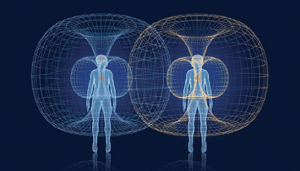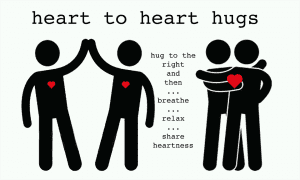
Your heart is an important symbol of love and life, and a critical part of the human body to sustain life. An open heart chakra is said to allow you to feel deeply connected, a harmonious exchange of energy with everything around you, and an appreciation of beauty. As we walk through the shops during the lead up to February it strikes us that love is most definitely all around!

The origins of Valentine’s day began in Ancient Rome where the Romans celebrated a spring festival, the feast of Lupercalia, to celebrate spring, fertility, the ancestors, and love. Women would put their names into an urn, and each bachelor would pick out a name and they would spend an entire year together. This practice continued in France and England, with the bachelor drawing a heart on his sleeve – which is where the phrase “wearing your heart on your sleeve” comes from. Later, the holiday was moved to the 14th of February to celebrate Saint Valentine.
Your heart is a magnificent organ that regulates, controls, and consistently supplies your body with the nutrients it requires to work seamlessly. This powerful organ begins to work from fetal development and commences beating well before the brain is formed. Your heart will then continue to beat at an average of 86,000 times a day and pump blood through a network of vessels over a distance of 100,000kms in a single day. This conveys the appreciation for the raw power of this amazing organ.
This organ alone could not function without your brain and nerve system. Research shows that your heart has 40,000 sensory neurons which have the role of sending important information to the brain. This means that our heart has a close relationship with how our brain perceives and processes information. The interconnectedness of the brain and heart is what makes your heart more important than what many people may realise. As an example, your heart is constantly adapting the pace at which it beats depending on your mood, activity, and what types of food you consume. Your heart almost has a brain of its own. Dr. J. Andrew Armour introduced the term, “heart brain” in 1991. Armour demonstrated that the heart’s complex nervous system qualified it as a “little brain.” The heart brain, similar to the proper brain, has intricate networks of neurons, neurotransmitters, proteins, and support cells. These networks allow your heart to act independently from the cranial brain as well as having extensive sensory capacities. Scientists at Heartmath Institute researched into the heart-brain connection and found that the heart sends signals to the brain that can influence perception, emotional expression, and higher brain function.

Did you know that when your heart beats it creates its own magnetic field that can be measured several meters from our body! This magnetic field can change based on our emotions. It has been proven others can detect the quality of your emotions through the electromagnetic energy emitted from your heart. The Heartmath Institute found heart rate variability and rhythms stood out as being the main indicator of internal emotional states. Negative emotions play a large role in creating distortions in heart rhythm, and in contrast to this, positive emotions restore more balance in the autonomic nerve system. These effects explain how thoughts can change your heart and in turn influence mental clarity, creativity, and personal effectiveness.
Did you also know that when a couple is in love their heart rates have the ability to synchronise? When you are involved in a romantic relationship your heartbeat mimics your partners, and this is known as co-regulation. Look at how intelligent your body is!
A key factor that affects your heart is your body’s function. Data from the 1999-2000 study of general practice in Australia illustrated that high blood pressure is the most common problem managed by doctors, accounting for 6% of all complaints. A report by the Australian Diabetes Obesity and Lifestyle study found that more than 3.6 million Australians over the age of 25 had high blood pressure or are medically managed for the rest of their lives.
This is where chiropractic comes into play. A chiropractors main objective is to restore nervous system function to allow the body to operate optimally. In a study performed by Budgell and Polus, reported in The Journal of Manipulative and Physiological Therapeutics (2006), they demonstrated that chiropractic spinal adjustments were linked with significant lowering of normal heart rate values and influenced the autonomic output of the heart. This illustrates that a shift in the neurological communication of the nervous system prompts the heart to slow or normalize.
So what are some steps you can follow for a happy, healthy heart?
- Come in and get checked! When your nervous system is working free of dysfunction, your organs – including your heart – work at their optimum. Simple!
- Move! Aim to be active every day. It is fine to start small and build up! Regular, moderate physical activity is great for your heart health.
- Eat well! Eating a balanced diet full of healthy fats, lots of fibre, protein and good carbs is critical to heart and overall health.
- Hug often! When we embrace someone, oxytocin is released allowing us to feel happy as well as promoting the feeling of trust and bonding. Hugs are also great for your physical health. Whilst hugging, your skin activates pressure receptors which send signals to the vagus nerve, an area of the brain responsible for lowering blood pressure, amongst other things. Embracing also reduces the amount of the stress hormone, cortisol, that is produced in our bodies. Win-win!

Our challenge for this month is to ensure we give ‘Heart to Heart’ hugs, that is hugs with our hearts touching. Often we hug loved one’s liver to liver. By instead leaning to the right and having our hearts touch, our energy fields expand. Muscle testing shows your body strengthens with a heart to heart hug.
Fun fact! Did you know that chiropractors in Australia are not allowed to hug our people without consent? That is right! Luckily we have the CCK ‘Consent to Hug’ form available to you!
Our hearts have travelled across the Tasman to join the community at CCK. We look forward to serving you and seeing your lovely smiles around the office.
Eat well, move, get adjusted, and live life from your heart.
~ Joseph and Emily


